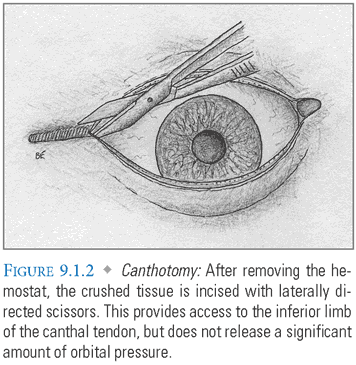

COMPLICATIONS
- Bleeding: This is anticipated but usually resolves without cauterization of the cut vessels. If persistent, hemostasis can usually be achieved by applying pressure over the lateral orbital rim.
- Incomplete decompression: It is essential to complete the cantholysis as inadequate decompression can result in irreversible optic neuropathy and blindness.
POSTOPERATIVE CARE
- Recheck the IOP and visual acuity after decompression to confirm improvement.
- Periodically apply ice packs to reduce lid edema.
- The lower lid may spontaneously heal without the need for additional surgery. If canthoplasty is required for cosmetic reasons, it may be completed within 1 to 2 weeks.
Further Reading
Text
Goodall KL, Brahma A, Bates A, et al. Lateral canthotomy and inferior cantholysis: an effective method of urgent orbital decompression for sight threatening acute retrobulbar haemorrhage. Injury. 1999;30(7):485–490.
Lima V, Burt B, Leibovitch I, et al. Orbital compartment syndrome: the ophthalmic surgical emergency. Surv Ophthalmol. 2009;54(4):441–449.
Vassallo S, Hartstein M, Howard D, et al. Traumatic retrobulbar hemorrhage: emergent decompression by lateral canthotomy and cantholysis. J Emerg Med. 2002;22(3): 251–256.
Wagner P, Lang GK. The eyelids. In: Ophthalmology: A Pocket Textbook Atlas. 2nd ed. New York, NY: Georg Thieme Verlag; 2007:17–49.
Primary Sources
Yung CW, Moorthy RS, Lindley D, et al. Efficacy of lateral canthotomy and cantholysis in orbital hemorrhage. Ophthal Plast Reconstr Surg. 1994;10(2):137–141.
9.2LID AND CANALICULAR LACERATION REPAIR
- Surgical repair of damage to the eyelids and/or lacrimal drainage system:
- Simple suture approximation of the affected layers is generally adequate, but significant tissue loss may require use of flaps or grafts.
- Canalicular lacerations should be suspected with injury to the medial lid and require stenting of the drainage system to preserve patency.
- Simple suture approximation of the affected layers is generally adequate, but significant tissue loss may require use of flaps or grafts.
INDICATIONS
- Traumatic damage to the lids, including lacerations, deep abrasions, tissue avulsion, puncture wounds, and blunt trauma.
- Patient stabilization takes precedence over lid repair.
- Cases requiring special management include:
- Lid margin injuries: Particular care is required because improper repair may lead to serious ocular surface defects.
- Canalicular injuries: Careful repair of the lacrimal drainage system is critical to preventing chronic epiphora and associated complications.
- Lid margin injuries: Particular care is required because improper repair may lead to serious ocular surface defects.
ALTERNATIVES
Conservative Management
- Some superficial injuries can be adequately treated with lid taping.
- Some puncture wounds can be permitted to heal by granulation if underlying structures have not been damaged.
RELEVANT PHYSIOLOGY/ANATOMY
Lid Anatomy (SEE FIG. 9.2.1A, B)
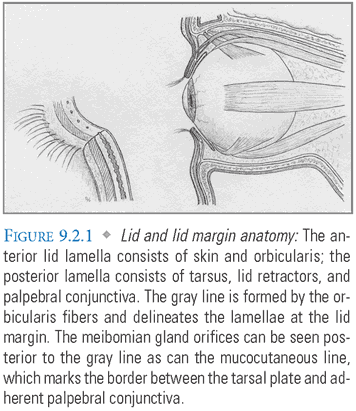
Lacrimal Drainage System Anatomy (SEE FIG. 9.2.2)
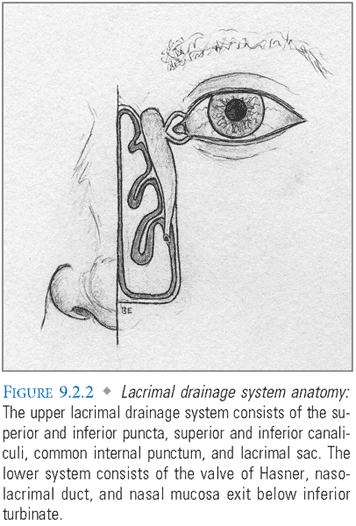
PREOPERATIVE ASSESSMENT
- Obtain a complete history, including timing and mechanism of injury, immunization status of patient and if animal bite involved (e.g., tetanus, rabies), and anticoagulant use.
- Document injuries with photographs and/or illustrations that include measurements of all defects.
- Retrobulbar hemorrhage must be ruled out due to the risk of permanent vision loss. Signs and symptoms include severe pain, reduced ocular motility and visual acuity, as well as increased intraocular pressure (IOP), edema, proptosis, and ecchymosis. If suspicion is high, perform a lateral canthotomy and cantholysis to decompress the orbit and prevent compressive optic neuropathy (see Chapter 9.1 Canthotomy/Cantholysis).
- Clarify the depth of the injury and the anatomical structures involved with a detailed external and slit lamp exam. Devote special attention to examining the lid margin and lacrimal drainage system and to assessing tissue loss.
- Palpate the facial and orbital bones for crepitus, step-offs, and instability. Computed tomography (CT) images of the face and orbits should be obtained if the exam or mechanism of injury suggests fracture.
- Check medial and lateral canthal tendon integrity to rule out traumatic dehiscence. This is accomplished by pulling the lid laterally and medially while observing movement of the puncta and lateral canthal angle, respectively (normally ≤1 to 2 mm).
- Rule out traumatic injury of the levator aponeurosis by assessing levator excursion (the difference in lid position between downgaze and upgaze). Normal excursion ranges from 16 to 20 mm; lower values suggest potential damage.
- Obtain baseline measurements with a Hertel’s exophthalmometer because enophthalmos is a common long-term consequence of trauma. Conversely, retrobulbar hemorrhage can produce proptosis. Anticipated normal values differ slightly based on race and gender. A difference between the eyes greater than 2 to 3 mm suggests a unilateral or asymmetric process.
- Assess visual acuity and check for an afferent pupillary defect (APD), which suggests unilateral or asymmetric damage to the retina or optic nerve.
- Probe and irrigate the canalicular system to assess integrity if there is any suspicion of injury. Saline should freely drain through the ipsilateral nare. Punctal reflux or wound site leakage is abnormal and should prompt further investigation.
ANESTHESIA
- Local infiltration of lidocaine with epinephrine can be used for most repairs. Adding hyaluronidase facilitates anesthetic distribution and decreases tissue distortion.
- Regional blocks that target branches of the trigeminal nerve produce less tissue swelling than local injections. Infraorbital, supraorbital, supratrochlear, and infratrochlear blocks are commonly used when repairing injuries to the ocular adnexa.
- General anesthesia may be required for young children and patients with complex defects or bony involvement.
- Topical anesthesia must be applied to the nasal mucosa prior to passing a silicon stent during canalicular laceration repair.
PROCEDURE
- Repair Timing: If the patient can be stabilized, lid repairs are ideally conducted between 12 and 24 hours of injury. This permits reduction of tissue edema, which is particularly important for identifying the cut ends of a lacerated canaliculus. If repair is delayed, the wounds should be covered with saline-moistened dressings to prevent tissue desiccation. It is also prudent to place a protective eye shield to prevent further damage.
- Medications: It may be necessary to update the patient’s tetanus immunization. Antibiotic prophylaxis is particularly important in cases of human or animal bites.
- General Principles:
- Prior to repair, it is important to irrigate the wound and remove embedded debris. Any devitalized tissue should be débrided.
- An operative plan is then developed that addresses each damaged structure.
- Penetration of the orbital septum can lead to fat prolapse and levator aponeurosis injury. If present, this is addressed with suture repair of the levator and overlying orbicularis. The orbital septum itself should not be closed due to the potential for postoperative lid retraction.
- Even without septal involvement, defects in the orbicularis should be reapproximated to avoid the development of lid contour irregularities.
- Skin can be closed with a running stitch, but interrupted sutures are preferred if the wound margins are irregular. Skin edges should be slightly everted during repair.
- Prior to repair, it is important to irrigate the wound and remove embedded debris. Any devitalized tissue should be débrided.
- Lid Margin Repair: Careful approximation is essential to prevent lid notching and other defects that may damage the ocular surface.
- Tarsal Reconstruction: Irregular tarsal lacerations should be trimmed to produce even surfaces (FIG. 9.2.1). A temporary suture can then be passed through the meibomian gland orifices on either side of the defect. Applying tension to this suture ensures even apposition of the cut tarsal edges (FIG. 9.2.2). Interrupted partial-thickness sutures are then placed to reapproximate the tarsus (FIG. 9.2.3).
- Lid Margin Reconstruction: The lid margin is realigned by passing fine silk sutures through the gray line and posterior lash line. A third suture through the mucocutaneous margin offers additional stability (FIG. 9.2.4). Sutures should enter and exit the lid margin 2 mm from the laceration and travel 2 mm deep within the lid tissue (FIG. 9.2.5). After they are tied, the tails are left long and tied away from the globe for easy identification and to guard against corneal abrasion.
- Superficial Closure: The orbicularis and skin are closed independently with interrupted sutures (FIG. 9.2.6). To prevent corneal irritation, the lid margin suture tails can be incorporated into the knots of the skin sutures (FIG. 9.2.7).
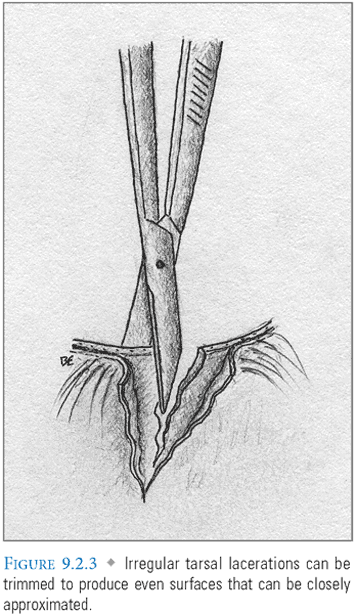

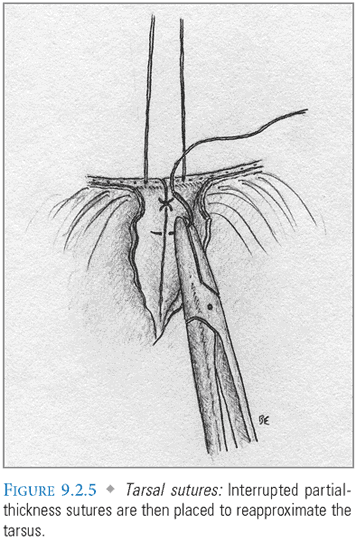
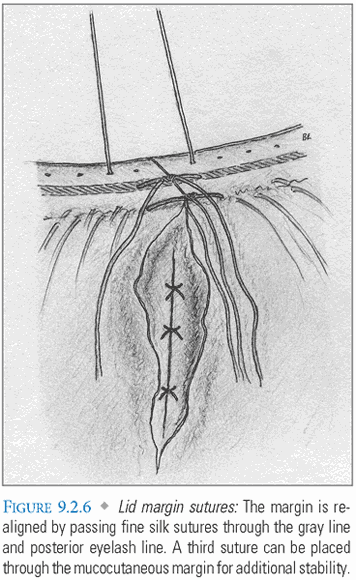

- Tarsal Reconstruction: Irregular tarsal lacerations should be trimmed to produce even surfaces (FIG. 9.2.1). A temporary suture can then be passed through the meibomian gland orifices on either side of the defect. Applying tension to this suture ensures even apposition of the cut tarsal edges (FIG. 9.2.2). Interrupted partial-thickness sutures are then placed to reapproximate the tarsus (FIG. 9.2.3).
- Canalicular Laceration: Repair entails identification of the cut canalicular ends, stenting of the lacrimal system, and suture repair.
- Canalicular Identification: Several methods exist for identifying the cut canalicular ends. The simplest entails inserting a punctal probe. As it is advanced, the probe should exit the proximal cut end of the canaliculus, and point to the distal cut end (FIG. 9.2.8). The canaliculus is only 1 to 1.5 mm in diameter, however, and the distal end may be hard to identify if there is significant tissue swelling. In difficult cases, dilute fluorescein or another distinctive liquid can be injected into the opposite canaliculus to facilitate identification (FIG. 9.2.9A). Alternatively, the surgical site can be flooded with saline. Air injected into the opposite canaliculus will then produce bubbles at the distal cut end (FIG. 9.2.9B).
- Stenting: After the proximal and distal cut ends are identified, a silicone stent with metal probes attached to both ends is threaded through the canaliculi and passed down the nasolacrimal duct into the ipsilateral nare. The probes are then removed, and the free ends of the stent are tied.
- Suture Repair: After stenting, end-to-end anastomosis of the cut canaliculus is performed with fine sutures. Alternatively, the ends can be indirectly approximated by placing horizontal mattress sutures in the adjacent lid tissue. The cut ends will then heal together over the stent.
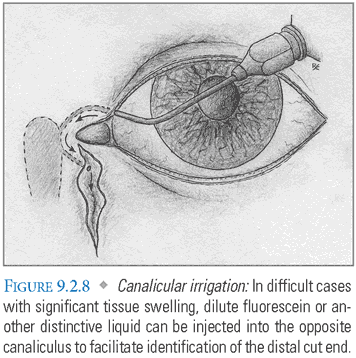
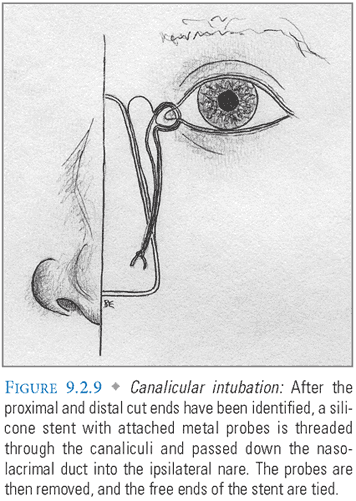
- Canalicular Identification: Several methods exist for identifying the cut canalicular ends. The simplest entails inserting a punctal probe. As it is advanced, the probe should exit the proximal cut end of the canaliculus, and point to the distal cut end (FIG. 9.2.8). The canaliculus is only 1 to 1.5 mm in diameter, however, and the distal end may be hard to identify if there is significant tissue swelling. In difficult cases, dilute fluorescein or another distinctive liquid can be injected into the opposite canaliculus to facilitate identification (FIG. 9.2.9A). Alternatively, the surgical site can be flooded with saline. Air injected into the opposite canaliculus will then produce bubbles at the distal cut end (FIG. 9.2.9B).
COMPLICATIONS
- Corneal erosion may be caused by the initial injury, aggressive cleaning, abrasion from suture tails or knots, or postoperative lid retraction.
- Ptosis can become apparent with the resolution of tissue edema if levator aponeurosis injuries were not initially identified and repaired.
- Infection of the lids is rare because they are highly vascular, but it may occur with inadequate cleaning, debridement, or antibiotic prophylaxis.
POSTOPERATIVE CARE
- Apply ice compresses and elevate the head of bed for 48 hours to decrease postoperative swelling, then switch to warm compresses.
- Apply antibiotic ointment to the wound for 2 to 3 days.
- Prescribe nonsteroidal anti-inflammatory drugs (NSAIDs) or mild narcotic medications for pain management.
- Alert the patient to signs of wound infection, including escalating pain, erythema, edema, or purulent discharge. Caution to avoid heavy lifting or Valsalva to prevent additional bleeding or dehiscence.
- Remove the skin sutures at 5 to 7 days for optimal cosmetic results (lengthier placement will result in more prominent scarring). The lid margin sutures should remain in place for 10 to 14 days to ensure a stable repair.
- During the cicatricial phase of wound healing (3 to 4 weeks), the patient can reduce contraction by massaging the scar.
- Leave canalicular stents in place for at least 3 months. Earlier removal may result in stricture formation and chronic epiphora.
Further Reading
Text
Green JP, Cheronis GC, Goldberg RA. Eyelid trauma and reconstructive techniques. In: Yanoff M, Duker J, eds. Ophthalmology. 3rd ed. Philadelphia, PA: Mosby; 2009:1443–1449.
Nelson CC. Management of eyelid trauma. Aust N Z J Ophthalmol. 1991;19(4):357–363.
Reifler DM. Management of canalicular laceration. Surv Ophthalmol. 1991;36(2):113–132.
Wagner P, Lang GK. The eyelids. In: Ophthalmology: A Pocket Textbook Atlas. 2nd ed. New York, NY: Georg Thieme Verlag; 2007:17–49.
Primary Sources
Jordan DR, Ziai S, Gilberg SM, Mawn LA. Pathogenesis of canalicular lacerations. Ophthal Plast Reconstr Surg. 2008;24(5):394–398.
Slonim CB. Dog bite-induced canalicular lacerations: a review of 17 cases. Ophthal Plast Reconstr Surg. 1996;12(3): 218–222.
9.3ORBITAL FLOOR FRACTURE REPAIR
- Repair of orbital floor fracture and placement of implant to prevent entrapment of orbital tissue and prevent or reverse enophthalmos after traumatic injury
INDICATIONS
Stay updated, free articles. Join our Telegram channel

Full access? Get Clinical Tree


